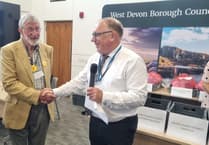THE FUTURE use of the Ash Moor pit near Petrockstowe was the subject of a secret meeting between DEFRA officials and local authority officers recently, notes of which have been leaked to the media.
The meeting, which was attended by officers from Devon County Council, West Devon Borough Council and Torridge District Council, revealed that future animal disease control activities would result in a move away from mass burial sites to landfill.
DEFRA's director of disposals Dr Mike Tas said landfill sites would be easier to incorporate into a national emergency strategy and this was something the Government would need to pursue, and an issue the national inquiries were likely to endorse.
But he indicated Ash Moor would not be disposed of until DEFRA was certain that the current outbreak was over and a future contingency plan was formulated.
Fifteen pits were due to be constructed to hold more than 400,000 animal carcasses at the height of the foot and mouth crisis.
But in the end only three pits were dug as other methods of burial were used and the backlog of carcasses reduced.
The site cost £7.5-million to construct and is currently costing £20,000 a week to maintain. Devon County Council, West Devon and Torridge MP John Burnett and local residents are calling for the site to be reinstated to grassland.
Mr Tas said the main issues for DEFRA were the environmental impact and the fact that restoration could be limited as much of the topsoil had been removed and redistributed.
There were also problems over the long-term ownership and custodianship of the site.
DEFRA recognised there had been difficulties over the creation of the Ash Moor pit.
But Mr Tas said they now wished to work in partnership with local authorities and others to come up with a solution prior to the outcome of the foot and mouth inquiries and they were not seeking any financial return.
The department has asked if there are any alternative uses for the site for perhaps quiet recreational use so some positive benefit could be accrued by the local community from what is at present 'a national asset'.
The notes of the meeting said the county council's view was that it had been 'steamrollered' into acceptance of the site in the face of a national emergency and was keen to see an environmental impact assessment completed on the site as this was in the final stages of preparation.
The notes continued: 'From general discussion it would appear that the draft environmental assessment indicates that the site is unsuitable for mass burial of diseased carcasses and this may present a political difficulty for DEFRA once this information was made public.'
The local authorities present told DEFRA officials of the strength of public feeling in the area against this site and of the general mistrust by the population toward DEFRA and the Government.
Mr Burnett said the Ash Moor pit was a vast drain of public money which should never have been built.
'They rushed at it like a bull in a china shop,' he said.
'This environmental impact assessment should have been done in the first place because it will probably tell us what we knew all along — that the site is totally unsuitable.'



